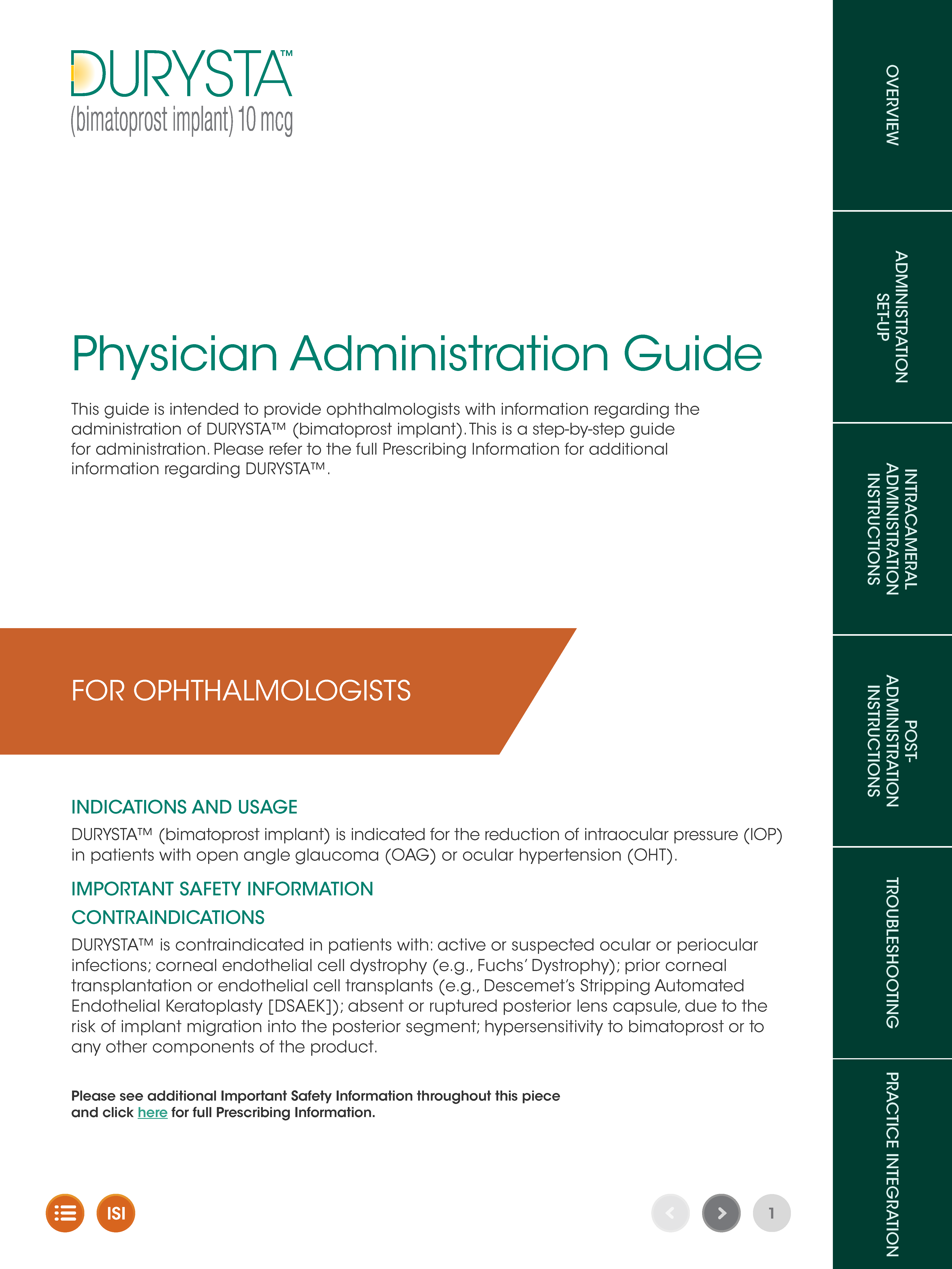Frequently Asked Questions About DURYSTA®

Q:What is DURYSTA®?
A:DURYSTA® (bimatoprost intracameral implant) is a prostaglandin analog indicated for the reduction of intraocular pressure (IOP) in patients with open angle glaucoma (OAG) or ocular hypertension (OHT). DURYSTA® is an intracameral implant that contains 10 mcg of bimatoprost within a solid polymer matrix. The implant slowly biodegrades over time. Treatment with DURYSTA® is limited to a single administration per eye.1,2 Learn more.
Q:How does DURYSTA® work?
A:DURYSTA® is believed to lower IOP by increasing outflow of aqueous humor through both the trabecular meshwork (conventional) and uveoscleral (unconventional) routes.1 Learn more about the MOA.
Q:How large is the DURYSTA® implant?
A:The DURYSTA® implant is approximately 1 mm in length and is administered via a 28-gauge needle.2
Q:Does DURYSTA® contain preservatives?
A:No. The DURYSTA® intracameral implant is preservative-free.3
Q:Are there any special storage considerations for DURYSTA®?
A:While in storage, DURYSTA® should be refrigerated at 2°C to 8°C (36°F to 46°F).1
Q:What is the IOP-lowering efficacy of DURYSTA®?
A:DURYSTA® was compared to twice-daily, topical timolol (0.5%) drops in 2 clinical studies. DURYSTA® demonstrated an IOP reduction of approximately 5-8 mm Hg (up to a 33% reduction) in patients with a mean baseline IOP of 24.5 mm Hg.1 Learn more about the full efficacy.
Q:What were the most common adverse reactions in clinical studies with DURYSTA®?
A:In Phase 3 clinical studies, the most common adverse reaction was conjunctival hyperemia, which occurred in 27% of patients. Other common adverse reactions reported in 5-10% of patients were foreign body sensation, eye pain, photophobia, conjunctival hemorrhage, dry eye, eye irritation, intraocular pressure increased, corneal endothelial cell loss, vision blurred, iritis, and headache.1 Learn more about the safety profile.
Q:Can DURYSTA® be used in pediatric patients?
A:Safety and effectiveness of DURYSTA® in pediatric patients have not been established.1
Q:Can DURYSTA® be used in patients with narrow anterior chamber angles?
A:Following administration with DURYSTA®, the intracameral implant is intended to settle within the inferior angle. DURYSTA® should be used with caution in patients with narrow iridocorneal angles (Shaffer grade < 3) or anatomical obstruction (eg, scarring) that may prohibit settling in the inferior angle.1 Learn more about administration and safety.
Q:Does DURYSTA® cause iris pigmentation?
A:Ophthalmic bimatoprost, including DURYSTA®, has been reported to cause changes to pigmented tissues, such as increased pigmentation of the iris. Pigmentation of the iris is likely to be permanent. Patients who receive treatment should be informed of the possibility of increased pigmentation. While treatment with DURYSTA® can be continued in patients who develop noticeably increased iris pigmentation, these patients should be examined regularly. In clinical trials, iris hyperpigmentation occurred in 1-5% of patients.1 Learn more about the safety profile.

For complete administration instructions, download the administration guide.
Q:How often is a new DURYSTA® implant administered?
A:DURYSTA® is an ophthalmic drug delivery system for a single intracameral administration of a biodegradable implant. DURYSTA® should not be readministered to an eye that received a prior DURYSTA®.1 Learn more about administration.
Q:Can I administer DURYSTA® to my patients in-office?
A:In the Phase 3 clinical trials, DURYSTA® was administered while patients were in the supine position. The procedure must be performed under magnification that allows clear visualization of the anterior chamber structures and should be carried out using standard aseptic conditions for intracameral procedures, with the patient's head in a stabilized position.1 See the administration guide for complete administration instructions.
Q:How do I know that I have achieved correct placement of the implant?
A:Following administration, the patient should remain upright for at least 1 hour after the procedure so the implant can settle. The implant typically settles into place in the inferior aspect of the anterior chamber at or near the 6 o’clock position once the patient is sitting upright.1 Read more about correct administration.
Q:Can I administer DURYSTA® to both eyes during the same visit?
A:DURYSTA® was not administered in both eyes of any subject in the clinical studies.
Q:What is used to administer DURYSTA®?
A:Each DURYSTA® intracameral implant comes preloaded in a single-use applicator with a 28-gauge needle.1,2

Q:Is there a copay program offered for my DURYSTA® patients?
A:Yes. The DURYSTA® Savings Program—eligible commercially-insured patients pay $0* for up to one implant per eye. Learn more.
Offer valid only for commercially-insured patients with plans covering DURYSTA®; patient out-of-pocket expense may vary. Offer not valid for patients receiving reimbursement from Medicare, Medicaid, or any other federal, state, or government-funded healthcare program. See Program Terms, Conditions, and Eligibility Criteria here or visit www.durystasavingsprogram.com.
Q:Are training and support materials available for my staff?
A:Yes. We offer a variety of resources around injection training, access support, and reimbursement support for your practice. Learn more about office resources.


